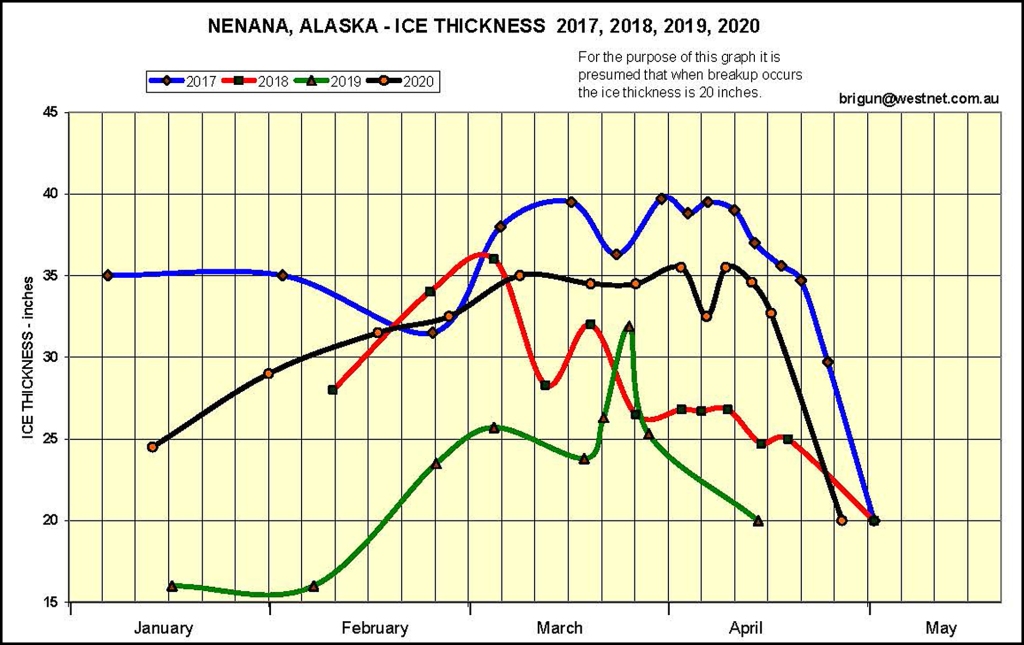THIS NOTE HAS BEEN REVISED AND UPDATED IN JULY 2021
https://briangunterblog.wordpress.com/2021/07/18/ctr-12-nenana-ice-breakup-alaska/

Records have been recorded since 1917 of the breakup of river ice in the Tanana River at the town of Nenana in central Alaska. A tripod is placed on the ice near the middle of the river each winter opposite the town wharf and the date and time of its collapse is recorded.

Details of the “Nenana Ice Classic”, where people estimate the date and time of the next breakup can be found at: www.nenanaakiceclassic.com/ This website also contains a webcam and a lot of data about historical ice breakups since 1917.
The Tanana River (about 940 km or 580 miles long) is a major tributary of the Yukon River in central Alaska, north of the Alaska Range. Its headwaters are near the Alaska-Yukon border from where it flows in a generally westerly direction, passing south of the city of Fairbanks. About 80 km (55 miles) downstream of Fairbanks is the town of Nenana and the Nenana River tributary.

The Tanana River freezes over in about December and typically achieves an ice thickness at Nenana of 40-50 inches (1-1.2 m) by early April. The collapse of the river ice (known as the “breakup”) typically occurs in late April or early May. The breakup usually occurs quite suddenly during the spring thaw and the resulting high river flows. The majority (80%) of breakups occur in the daytime between 9 am and 8 pm.
This post, and earlier posts, analyses the variation in the date of breakup since 1917. It also presents the variation in ice thickness in each year since 1989 and its relation to the date of river breakup.
Earlier posts of mine are:
https://briangunterblog.wordpress.com/2016/04/14/nenana-ice-breakup-alaska/ Analysis of data 1917-2015.
https://briangunterblog.wordpress.com/2016/04/25/nenana-ice-breakup-alaska-2016/ Update including 2016 breakup.
https://briangunterblog.wordpress.com/2018/04/30/nenana-ice-breakup-alaska-2018-update/ (Update 2017-2019).
This present post is an update including the 2020 breakup at Nenana. Also included is a link to a similar analysis of the breakup dates in the Yukon River at Dawson City.
THE 2020 BREAKUP
The 2020 breakup occurred at 12:56 pm (AKST) on 27 April. This was close to the average breakup date according to the trend since records commenced in 1917.
BREAKUPS IN 2017, 2018, 2019 & 2020

ANNUAL BREAKUP DATES & TREND


MAXIMUM ICE THICKNESS

ICE THICKNESS AT 1 APRIL
YUKON RIVER BREAKUP
There is a close correlation with the breakup in the Yukon River at Dawson City, Canada where breakup data are available since 1896. https://briangunterblog.wordpress.com/2018/05/20/yukon-river-breakup-canada/
The Yukon river breakup occurs, on average, 8 to 10 days later than at Nenana.
In 2020 the Yukon River at Dawson City breakup occurred on 25 April two days earlier than at Nenana.
COMMENTS
The breakup of the ice in 2020 at Nenana was about average according to the trend since 1917. The ice thickness up to mid-April was greater than 30″ which is an indicator of an “average” winter in Alaska. Breakup occurred on 27 April.
The dates of the annual breakup at Nenana have decreased by about ten days over the past century. However this decrease has not been uniform. Between 1917 and 1970 the average breakup date was 6 May, but since 1970 the average breakup date has been 2 May. This decrease may be due to slightly warmer winters (or springs) over the past century, although development of the Fairbanks region since 1970 may also have had an influence.
The date of the breakup is almost independent of the maximum thickness of ice during the winter. During the past 32 years, since 1989, the breakup generally occurs (80% of the time) between 28 April and 12 May irrespective of how cold the preceding winter has been. It is therefore suggested that the breakup date is mainly dependent on rising temperatures in spring (which causes snowmelt) and spring rainfall (which increases the snowmelt and can also produce floods and ice-jams in the rivers). It was reported on 24 April 2020 (NWS Fairbanks) that ice and log jams existed in the Chena River (an upstream tributary of the Tenana River) which indicated the impending breakup at Nenana.
There is a strong correlation between the breakup dates at Nenana and in the Yukon River at Dawson City. This indicates that similar physical factors affect the breakup in the two catchments.
Any comments on the above?

